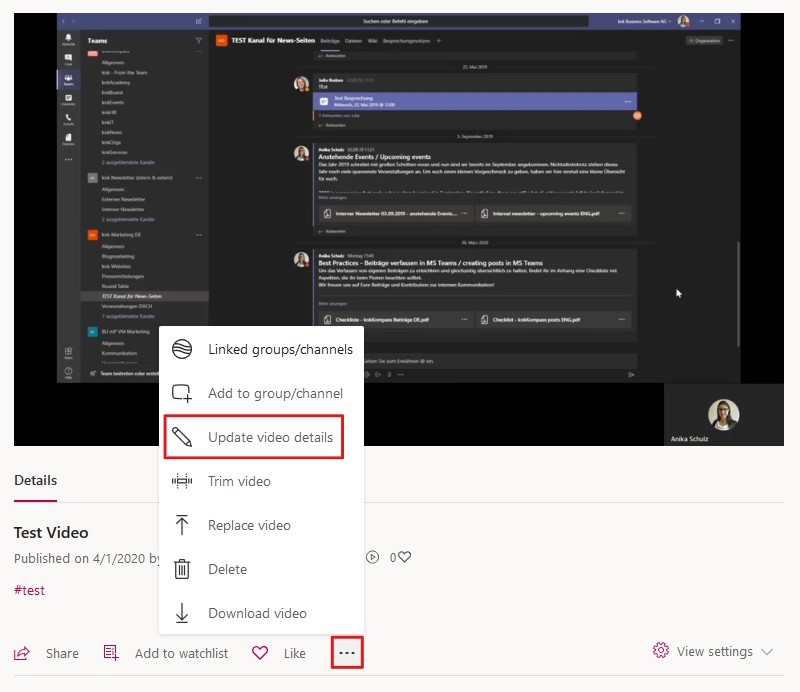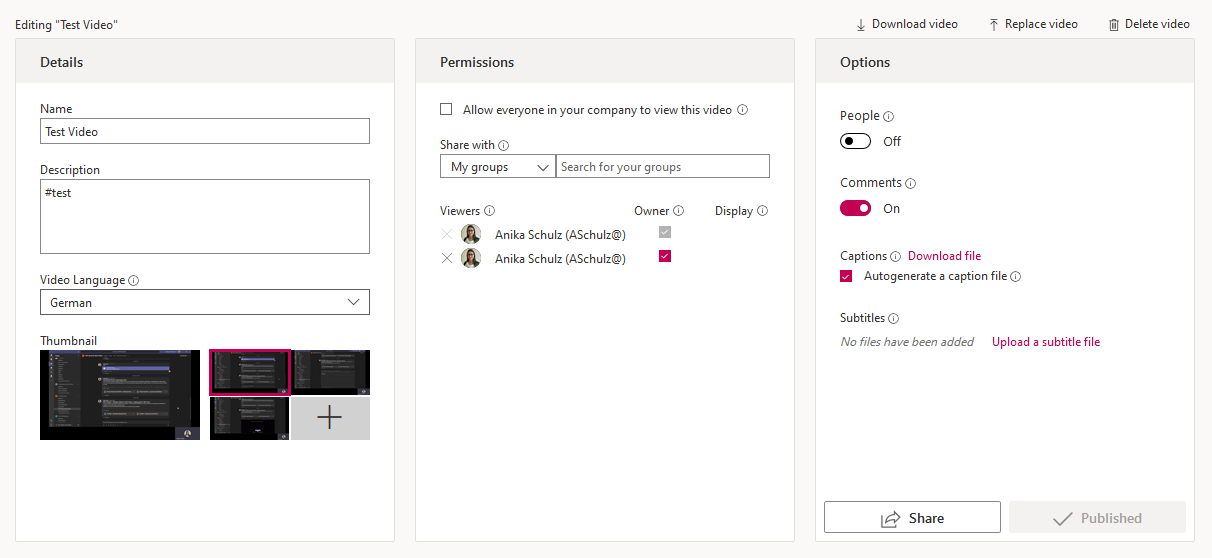In order to organize and share your internal company knowledge, transparently and effectively, the Microsoft video service Stream is the ideal solution.
In addition to a central storage location for videos and recordings, live events can also be organized via Stream. Stream offers great added value when it comes to knowledge-transfer but also to transparent communication and a uniform level of information.
In the following we would like to share with you what functions Stream offers you and which application options and best practices have proven themselves in the knk group.
Functions of Stream
Uploading videos / editing details
The basic concept of Stream is to upload videos and make them available to others. In Stream, you can upload your own videos, and recordings from Microsoft Teams are also automatically made available here.
Once your video is uploaded, you can edit it. In addition to inserting title, description and tags, you can also crop the video or activate the transcript.



If you have activated the transcript, it will appear to the right of the video. Use ‘Edit transcript’ to customize the transcript to suit your needs.
The video can be shared either with individuals, channels and teams or with your entire organization:
If you upload a video yourself, the default option is to allow everyone in your organization to view the video. However, by default, recorded meetings are only available to participants. To customize the permissions according to your wishes, open the ‘update video details’ by clicking the button with the three dots. Under permissions, you can now share the video with specific people, channels, groups, or your entire company. This setting is very important because only authorized people can access the video, even if it has been explicitly shared.
If you have enabled the ‘People’ setting, Stream will scan the video for different people through its face detection feature, and you can name them. This way, viewers can later search for parts of the video with specific speakers.
Using the ‘Interactivity’ field, surveys, votes or quizzes can be integrated directly into the video at the desired point on the timeline.
Usage
The share function allows you to copy a divisible link, send a video by e-mail or generate a link that allows you to embed it directly into other applications.
In addition to sharing, you can also like a video, which allows Stream to create trends and suggest popular content to users in your organization.
Not only can you browse your groups and created channels and search for videos in a targeted manner, but you can also create your own watchlist.
Downloading is just as easy as uploading videos. Please note that the transcript is not automatically downloaded. However, you can download it separately and then integrate it into your usual video player.
If the owner of a video has activated the option for subtitles, you can have them displayed directly in the video via ‘Settings’ and adjust the captions/subtitles settings there.
Organized filing
Stream offers you the option to assign your videos to groups or channels.
The groups in Stream are taken from Office365 and so Streams should automatically show you the groups you know from Microsoft Teams or Planner.
Channels are not linked in this way and can be created in the way that best suits the structured storage of your videos. For example, you can create channels for different topics, formats or regions within your group.
Live events
In addition to sharing videos, Stream also allows you to plan and run live events. Live events are digital meetings in which the interaction between speakers and participants is controlled by a moderator. The live event can either be accessible to the entire organization or limited to specific groups or individuals.
This format is particularly suitable for company-wide events or reports from the management team.
For more information on live events, please refer to our series of articles “Live Events without live audience”.
Integration
As part of the Microsoft stack, Stream is seamlessly connected to other Microsoft products, such as Teams, SharePoint, OneNote, PowerPoint, Yammer or Forms. Over the coming weeks, we will introduce you to some of these applications in our series of articles and webinars on Microsoft tools.
Meetings recorded in Teams are automatically uploaded to Stream and videos or channels from Stream can be attached within Teams as tabs.
In OneNote and PowerPoint, videos can be inserted and displayed directly at the desired location.
How are we using Stream?
In the knk group, in addition to its function as an information library and presentation filing, Stream has proven itself for the following formats:
Status meeting and Live Compass
We communicate operational updates and news in our status meeting at regular intervals. ‘Live Compass’, a live Teams event that takes place at shorter intervals but serves a similar purpose, was recently established.
These status updates, as well as information from the management team, are made available to all employees on Stream so that they can access and view the recording afterwards if they were unable to attend the event.
knowledge2go
The “knowledge2go” format (short k2g) are short sessions in which we internally share our knowledge on various topics. Participation in this 30-minute live event is open to everyone and every employee can suggest topics or conduct a k2g session themselves.
Each session is recorded and uploaded to Stream in our k2g channel, contributing to our growing library of internal knowledge. This is especially useful for onboarding new employees and internal training.
Best Practices
Set the language
When we upload a video, we always set the appropriate language in the video details and activate the subtitle option so that our international colleagues can also access the content.
Trimming the video
Especially when a video is a recorded meeting, it is recommended that you adjust the video’s start and end points to provide only what is really important.
Title, description and tags
Our best practice of making the title and description as clear and meaningful as possible not only makes it easy to search for content, but also allows you to quickly decide how important or interesting a video is.
We also try to keep the tags used in the description as consistent as possible with those of our other tools, like Microsoft Teams posts.
Enable auto-scroll
If you are displaying a video transcript, we recommend using the auto-scroll function, found under ‘more actions’. This sets the transcript so that it automatically scrolls with the spoken word.
Notification settings
For us, disabling email notifications when frequently recording Teams meetings has proven to be convenient. We find them more annoying than helpful, since these recordings are automatically uploaded but the notification is delivered with a certain delay.
Find our checklist here
To get an idea where to start, take a look at our checklist for personal use. Download: Checklist – MS Stream Best Practices.
With its structured filing options, support for live events and seamless integration with other Office365 applications, such as Microsoft Teams, Stream is ideal for sharing, storing and organising internal knowledge and information.
If you have any questions about the implementation of Stream or would like to know more about the formats we use at the knk group to get the most benefit from the added value of this tool, please contact us by e-mail at knkServices@knk.de.
(Photo by William Bayreuther on Unsplash)
The knk blog team fills the knk blog with content, new posts and replies to comments.
We welcome your comments!

Leave A Comment